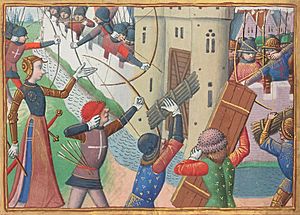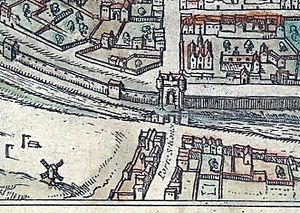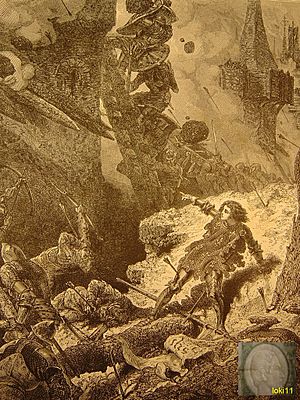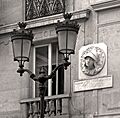Siege of Paris (1429) facts for kids
Quick facts for kids Siege of Paris (1429) |
|||||||
|---|---|---|---|---|---|---|---|
| Part of the Hundred Years' War (1415–53 phase) | |||||||
 Joan of Arc at the porte Saint-Honoré during the siege of Paris of 1429 |
|||||||
|
|||||||
| Belligerents | |||||||
| Commanders and leaders | |||||||
| Strength | |||||||
| 10,000 | 3,000 English citizens of Paris |
||||||
| Casualties and losses | |||||||
| 500 dead 1,000 wounded |
|||||||
The Siege of Paris in September 1429 was a major attack during the Hundred Years' War. King Charles VII and his army, including the famous Joan of Arc, tried to capture the city of Paris. At this time, Paris was controlled by the English and their allies, the Burgundians.
However, King Charles's French troops could not get into Paris. The city was strongly defended by its governor, Jean de Villiers de L'Isle-Adam, and its provost, Simon Morhier. Most of the people living in Paris also supported the defenders.
Contents
Why Paris Was Attacked: The Background
After Henry V of England took control of Paris in 1420, the English government was quite kind to the people of Paris. They confirmed old rights and gave new ones. Parisians generally accepted English rule. This was mainly because they disliked Charles VII, whom they called "King of Bourges". They also disliked the Armagnac party, who they felt threatened the freedoms Paris had gained over many years.
Preparing for the Siege
After a battle at Montépilloy on August 26, 1429, Joan of Arc and Duke John II of Alençon captured Saint-Denis. This town is just north of Paris.
On August 28, King Charles VII signed a truce, or peace agreement, called the truce of Compiègne. This truce did not include Saint-Denis (which was already taken), St. Cloud, Vincennes, Charenton, or Paris. This meant fighting could still happen in these areas.
In early September, Charles VII set up his army camp at the Saint-Roch hill.
On September 3, Joan of Arc arrived with several important leaders. These included the Dukes of Alençon and Bourbon, the Counts of Vendôme and Laval, and Marshals Gilles de Rais and La Hire. They stayed in the village of La Chapelle. For several days, they explored and had small fights near different gates of Paris. Joan of Arc also prayed in the St. Genevieve chapel.
The Attack on Paris
On the morning of Thursday, September 8, 1429, Joan of Arc led the attack. She was joined by the Duke of Alençon and Marshals Gilles de Rais and Jean de Brosse Boussac. They marched from the Village of La Chapelle to attack the Porte Saint-Honoré gate. Joan of Arc placed cannons, called culverins, on the Saint-Roch hill to help with the attack.
The people of Paris believed that the Armagnacs wanted to completely destroy their city. Because of this, they defended Paris very strongly. Charles VII had given Joan of Arc the job of leading the main assault to capture the city.
Joan of Arc and the French army charged towards the main gate. They tried to cross the city's moat, which was filled with water, right in front of the gate. However, the French army failed to capture any part of the gatehouse or the walls around it. They suffered many casualties, meaning many soldiers were killed or wounded. During the fight, Joan of Arc was hit in the thigh by a crossbow bolt. She was then taken away from the battle and brought back to her house in La Chapelle.
Even though Joan wanted to continue the attack on Paris, Charles VII ordered his army to retreat to the Abbey of Saint-Denis. After four hours of attacking the walls of Paris, Charles VII called for a retreat because no progress had been made. The city remained under English control.
What Happened Next
About 3,000 English soldiers, led by Marshal Simon Morhier and Governor Jean de Villiers de L'Isle-Adam, defended Paris. They successfully forced Charles VII and his army of 10,000 soldiers to retreat.
Since force didn't work, Charles VII tried other ways to take the city. In 1430, he planned a secret plot, but the English discovered it. This led to six Parisians being hanged. In 1432 and 1434, there were more attempts to open the gates of Paris to Charles VII's forces, but Parisians stopped them.
Finally, the Duke of Burgundy stopped supporting the English after the Treaty of Arras (1435). On April 13, 1436, the people of Paris opened the city gates to Jean de Dunois and Arthur de Richemont. This allowed Charles VII's forces to finally take control of Paris.
Images for kids





